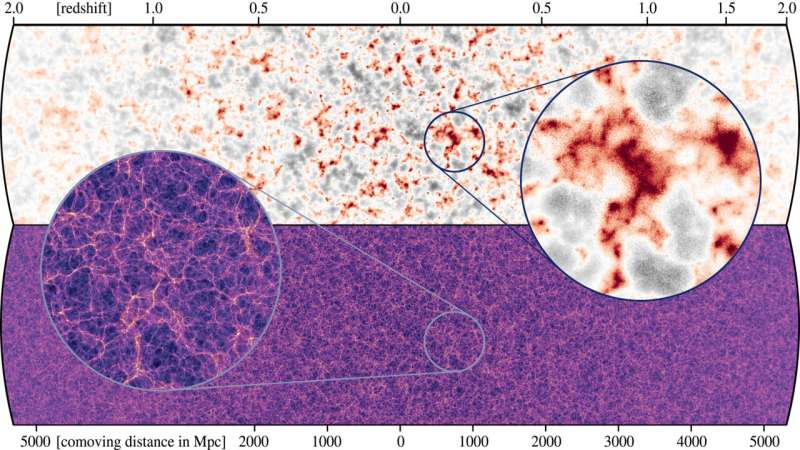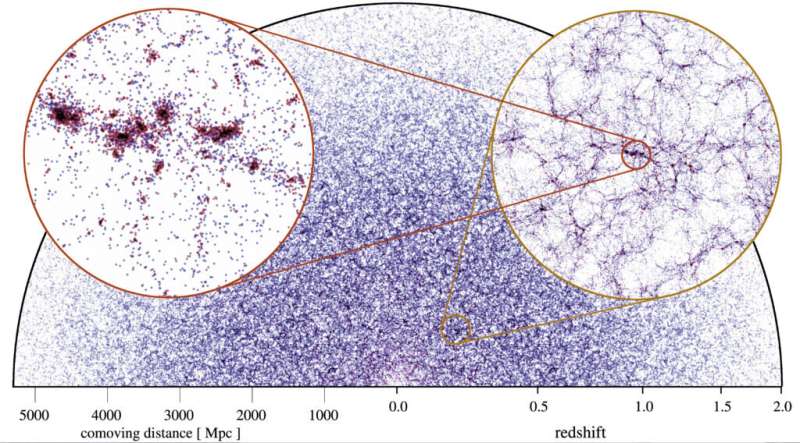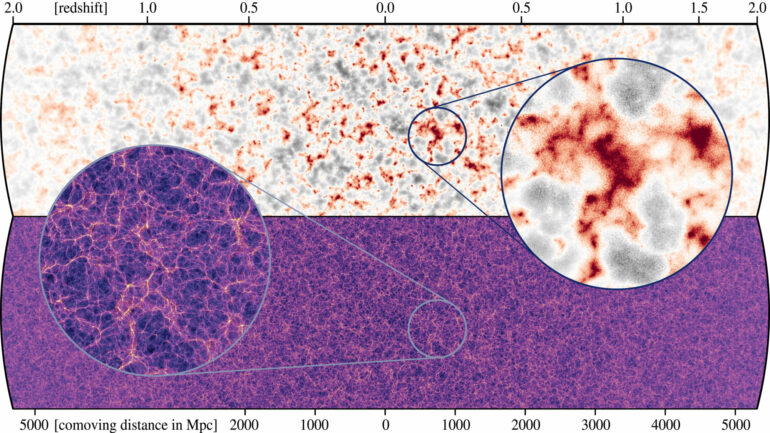York University and an international team of astrophysicists have made an ambitious attempt to simulate the formation of galaxies and cosmic large-scale structure throughout staggeringly large swaths of space.
First results of their MillenniumTNG project are published in a series of 10 articles in the journal Monthly Notices of the Royal Astronomical Society. The new calculations help to subject the standard cosmological model to precision tests and to unravel the full power of upcoming new cosmological observations, say the researchers including York Assistant Professor Rahul Kannan.
In recent decades, cosmologists have gotten used to the perplexing conjecture that the universe’s matter content is dominated by enigmatic dark matter and that an even stranger dark energy field that acts as some kind of anti-gravity to accelerate the expansion of today’s cosmos. Ordinary baryonic matter makes up less than five percent of the cosmic mix, but this source material forms the basis for the stars and planets of galaxies like our own Milky Way.
This seemingly strange cosmological model is known under the name LCDM. It provides a stubbornly successful description of a large number of observational data, ranging from the cosmic microwave radiation—the rest-heat left behind by the hot Big Bang—to the “cosmic web,” where galaxies are arranged along an intricate network of dark matter filaments. However, the real physical nature of dark matter and dark energy is still not understood, prompting astrophysicists to search for cracks in the LCDM theory.
Identifying tensions to observational data could lead to a better understanding of these fundamental puzzles about our universe. Sensitive tests are required that need both: powerful new observational data as well as more detailed predictions about what the LCDM model actually implies.
An international team of researchers led by the Max Planck Institute for Astrophysics (MPA) in Germany, Harvard University in the U.S., Durham University in the U.K., and the Donostia International Physics Center in Spain, along with York University, have now managed to take a decisive step forward on the latter challenge.
Building up on their previous successes with the Millennium and IllustrisTNG projects, they developed a new suite of simulation models dubbed MillenniumTNG, which trace the physics of cosmic structure formation with considerably higher statistical accuracy than what was possible with previous calculations.
Large simulations including new physical details
The team utilized the advanced cosmological code GADGET-4, custom-built for this purpose, to compute the largest high-resolution dark matter simulations to date, covering a region nearly 10 billion light-years across. In addition, they employed the moving-mesh hydrodynamical code AREPO to follow the processes of galaxy formation directly, throughout volumes still so large that they can be considered representative for the universe as a whole.
Comparing both types of simulations allows a precise assessment of the impact of baryonic processes related to supernova explosions and supermassive black holes on the total matter distribution. An accurate knowledge of this distribution is key for interpreting upcoming observations correctly, such as so-called weak gravitational lensing effects, which respond to matter irrespective of whether it is of dark or baryonic type.

Figure 2: Comparison of the neutrino (top) and dark matter (bottom) distributions on the past backwards lightcone of a fiducial observer positioned at the centre of the two horizontal stripes. As cosmic expansion slows down the neutrinos at late times (small redshift/distance), they start to weakly cluster around the biggest concentrations of dark matter as shown by a comparison of the zoomed insets. This slightly increases the mass and further growth rate of these largest structures. © MPA
Furthermore, the team included massive neutrinos in their simulations, for the first time in simulations big enough to allow meaningful cosmological mock observations. Previous cosmological simulations had usually omitted them for simplicity, because they make up at most one to two percent of the dark matter mass, and since their nearly relativistic velocities mostly prevent them from clumping together.
Now, however, upcoming cosmological surveys (such as those of the recently launched Euclid satellite of the European Space Agency) will reach a precision allowing a detection of the associated percent-level effects. This raises the tantalizing prospect to constrain the neutrino mass itself, a profound open question in particle physics, so the stakes are high.
For their MillenniumTNG simulations, the researchers made efficient use of two extremely powerful supercomputers, the SuperMUC-NG machine at the Leibniz Supercomputing Center in Garching, and the Cosma8 machine at Durham universe. More than 120,000 compute cores toiled away for nearly two months at SuperMUC-NG, using computing time awarded by the German Gauss Center for Supercomputing, to produce the most comprehensive hydrodynamical simulation model to date.
MillenniumTNG is tracking the formation of about one hundred million galaxies in a region of the universe around 2,400 million light-years across (see Figure 1). This calculation is about 15 times bigger than the previously best is this category, the TNG300 model of the IllustrisTNG project.
Using Cosma8, the team computed an even bigger volume of the universe, filled with more than a trillion dark matter particles and more than 10 billion particles for tracking massive neutrinos (see Figure 2). Even though this simulation did not follow the baryonic matter directly, its galaxy content can be accurately predicted in MillenniumTNG with a semi-analytic model that is calibrated against the full physical calculation of the project. This procedure leads to a detailed distribution of galaxies and matter in a volume that for the first time is large enough to be representative for the universe as a whole, putting comparisons to upcoming observational surveys on a sound statistical basis.
Theoretical predictions for cosmology
The first results of the MillenniumTNG project show a wealth of new theoretical predictions that reinforce the importance of computer simulations in modern cosmology. The team has written and submitted 10 introductory scientific papers for the project. Eight of them have just appeared simultaneously in the journal MNRAS, the remaining two are about to follow shortly and are currently available on the arXiv preprint server.
One timely study examines the discovery of a population of very massive galaxies in the young universe with the James Webb Space Telescope. The masses of these galaxies are unexpectedly large just a brief time after the Big Bang, seemingly defying theoretical expectations. Dr. Kannan analyzed the predictions of MillenniumTNG for this early epoch. While the simulations agree with the observations out to redshifts of z=10 (when the universe was less than 500 million years old), he confirmed that, if they hold up, the new results by JWST at even higher redshift conflicts with the simulation predictions.

Figure 3: Galaxy distribution on the past backwards lightcone in MillenniumTNG, where the galaxies are predicted with a sophisticated semi-analytic model on top of the dark matter backbone. Galaxies are shown down to Johnson apparent magnitude 𝑅 0.7, and blue otherwise. Real observations of the galaxy positions would additionally be perturbed by small shifts along the line of sight due to the Doppler effects from the galaxies’ motions, an effect that can also be easily included in the models. The two circular insets show nested zooms with diameters of around 1.25 billion light-years and 125 million light-years, and fainter apparent magnitude limits of 𝑅
“Perhaps star formation is much more efficient shortly after the Big Bang than at later times, or maybe massive stars are formed in higher proportions back then, making these galaxies unusually bright,” says Kannan of York University’s Faculty of Science.
Another study looked at the shapes of galaxies. Nearby galaxies have the subtle tendency to orient their shapes in similar directions instead of pointing randomly, an effect called “intrinsic galaxy alignments.” This poorly understood effect distorts inferences based on weak gravitational lensing, which creates its own statistical alignment signal. The MillenniumTNG project could for the first-time measure intrinsic alignments with very high signal-to-noise directly from the shapes of the simulated galaxies, out to distances of several hundred million light-years.
“Perhaps our determination of the intrinsic alignment of galaxy orientations can help to resolve the current discrepancy between the amplitude of matter clustering inferred from weak lensing and from the cosmic microwave background,” says Ph.D.-student Ana Maria Delgado of Harvard University, first author of this study of the MillenniumTNG team. Using these results, astronomers will be able to correct for this important systematic effect much better.
Other works of the team’s initial analysis focus on the clustering signals of galaxies. For example, MPA Ph.D. student Monica Barrera produced extremely large and highly realistic mock catalogs of galaxies on the past backwards “lightcone” of a fiducial observer (see Figure 3). In this case, galaxies that are more distant are also automatically younger, reflecting the travel time of the light that is reaching our telescopes. Using these virtual observations, she looked at the so-called baryonic acoustic oscillation (BAO) feature (which provides a cosmologically important standard ruler) in the projected two-point correlation function of galaxies.
Her results showed that measuring these BAOs is a fairly tricky endeavor that can be significantly influenced by so-called cosmic variance effects—even when extremely large volumes are studied in observational surveys. While in simulations one can observe the modeled universe from different vantage points to recover the correct statistical ensemble average, this is unfortunately not readily possible for the real universe. “The MillenniumTNG simulations are so big and contain so many galaxies, more than 1 billion in the biggest calculation, that it was really hard to study them,” says Monica Barrera. “Analysis scripts that work just fine for smaller simulations tend to take forever for MillenniumTNG.”
Analyzing cosmological data
The flurry of first results from the MillenniumTNG simulations make it clear that they will be of great help to design better strategies for the analysis of upcoming cosmological data. The team’s principal investigator, Professor Volker Springel from MPA argues that “MillenniumTNG combines recent advances in simulating galaxy formation with the field of cosmic large-scale structure, allowing an improved theoretical modeling of the connection of galaxies to the dark matter backbone of the universe. This may well prove instrumental for progress on key questions in cosmology, such as how the mass of neutrinos can be best constrained with large-scale structure data.”
The MillenniumTNG simulations produced more than three Petabytes of simulation data, forming a rich asset for further research that will keep the participating scientists busy for many years to come.
More information:
Boryana Hadzhiyska et al, The MillenniumTNG Project: refining the one-halo model of red and blue galaxies at different redshifts, Monthly Notices of the Royal Astronomical Society (2023). DOI: 10.1093/mnras/stad279
Rüdiger Pakmor et al, The MillenniumTNG Project: the hydrodynamical full physics simulation and a first look at its galaxy clusters, Monthly Notices of the Royal Astronomical Society (2023). DOI: 10.1093/mnras/stac3620
César Hernández-Aguayo et al, The MillenniumTNG Project: high-precision predictions for matter clustering and halo statistics, Monthly Notices of the Royal Astronomical Society (2023). DOI: 10.1093/mnras/stad1657
Ana Maria Delgado et al, The MillenniumTNG project: intrinsic alignments of galaxies and haloes, Monthly Notices of the Royal Astronomical Society (2023). DOI: 10.1093/mnras/stad1781
Sergio Contreras et al, The MillenniumTNG Project: inferring cosmology from galaxy clustering with accelerated N-body scaling and subhalo abundance matching, Monthly Notices of the Royal Astronomical Society (2023). DOI: 10.1093/mnras/stac3699
Boryana Hadzhiyska et al, The MillenniumTNG Project: an improved two-halo model for the galaxy–halo connection of red and blue galaxies, Monthly Notices of the Royal Astronomical Society (2023). DOI: 10.1093/mnras/stad731
Rahul Kannan et al, The MillenniumTNG project: the galaxy population at z ≥ 8, Monthly Notices of the Royal Astronomical Society (2023). DOI: 10.1093/mnras/stac3743
Sownak Bose et al, The MillenniumTNG Project: the large-scale clustering of galaxies, Monthly Notices of the Royal Astronomical Society (2023). DOI: 10.1093/mnras/stad1097
Monica Barrera et al, The MillenniumTNG Project: Semi-analytic galaxy formation models on the past lightcone, arXiv (2022). DOI: 10.48550/arxiv.2210.10419
Fulvio Ferlito et al, The MillenniumTNG Project: The impact of baryons and massive neutrinos on high-resolution weak gravitational lensing convergence maps, arXiv (2023). DOI: 10.48550/arxiv.2304.12338
Citation:
New computer simulations follow the formation of galaxies and cosmic large-scale structure with precision (2023, July 20)



